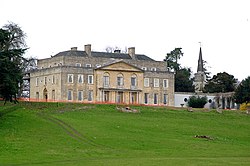Gatton Hall, Surrey
| Gatton Hall | |
| Surrey | |
|---|---|
 Gatton Hall and Church | |
| Location | |
| Grid reference: | TQ27515281 |
| Location: | 51°15’37"N, 0°10’26"W |
| History | |
| Country house | |
| Palladian | |
| Information | |
| Condition: | Converted to a school |
| Owned by: | The Royal Alexandra and Albert School |
Gatton Hall is a grand country house by Gatton near Reigate in Surrey. It styands in the midst of Gatton Park, though the house and the park have been sundered: the park is in the hands of the National Trust, while the house has become The Royal Alexandra and Albert School.
The house is a Grade II listed building.[1] The park is Grade II listed on the Register of Historic Parks and Gardens.[2]
History
In the 17th century, the estate is mentioned as being in the possession of John Weston of Sutton Place, Surrey, the second and eldest surviving son of Sir Richard III Weston) and his wife, Mary Copley (daughter and heiress of William Copley of Gatton) until 1654.[3]
About 1748 Sir James Colebrooke acquired Gatton Park from William Newland, with the proprietorship of the Borough of Gatton,[4] and his brother Sir George Colebrooke had the park landscaped by Capability Brown between 1762 and 1768.[5]
In 1789 Thomas Kingscote went to live at Gatton Park after his friend, Robert Ladbroke, had bought it in the same year. It was a notorious pocket borough and Thomas went there in order to manage the election of Ladbroke's nominees. Ladbroke bought it from the Graham family.
Gatton was purchased by Frederick John Monson, 5th Baron Monson (1809–1841), for £100,000, for the ancient privilege of sending two members to the House of Commons, a perquisite that was cancelled two years later. He set about remaking Gatton Hall splendid: for him. The architect Thomas Hopper made alterations to Gatton, but further plans were not executed.[6] The marble hall at the centre of the main block was revetted in marble, even to the inlaid marbles of its floor, taking as a general model the Corsini Chapel in San Giovanni in Laterano, though Lord Monson did not cap his hall with a dome. The walls were frescoed by Joseph Severn with the Four Classical Virtues, embodied by historical ladies.
In 1841 the estate was inherited by the 6th Baron Monson who lived in Lincolnshire and who let Gatton, first to his aunt and then to Hugh Cairns, 1st Earl Cairns, the Attorney General.[7]
The estate was purchased in 1888 by Sir Jeremiah Colman whose family had established the Colman's mustard food brand in the early 19th century. The property was requisitioned during the Second World War; the estate was then purchased by the current owners, The Royal Alexandra and Albert School.[8]
Outside links
| ("Wikimedia Commons" has material about Gatton Park) |
References
- ↑ National Heritage List 1377943: Gatton Hall (Grade II listing)
- ↑ National Heritage List 1001409: Lower Gatton Park (Register of Historic Parks and Gardens)
- ↑ Harrison, Frederic: 'Annals of an Old Manor House: Sutton Place' (1899) pp. 116,134 and 137
- ↑ Manning, Owen and Bray, William: 'The History and Antiquities of the County of Surrey', (1803-14, reprinted 1974)
- ↑ Article on the restoration of the Park to Brown's original plans in The Times
- ↑ Colvin, Howard: 'A Biographical Dictionary of British Architects, 1600-1840', 3rd ed. (Yale University Press) 1995, s.v. " Thomas Hopper".
- ↑ "The Life and Times of Burton Folk". http://www.burton-by-lincoln.info/burton%20folk%201861.pdf.
- ↑ Cite error: Invalid
<ref>tag; no text was provided for refs namedgp
